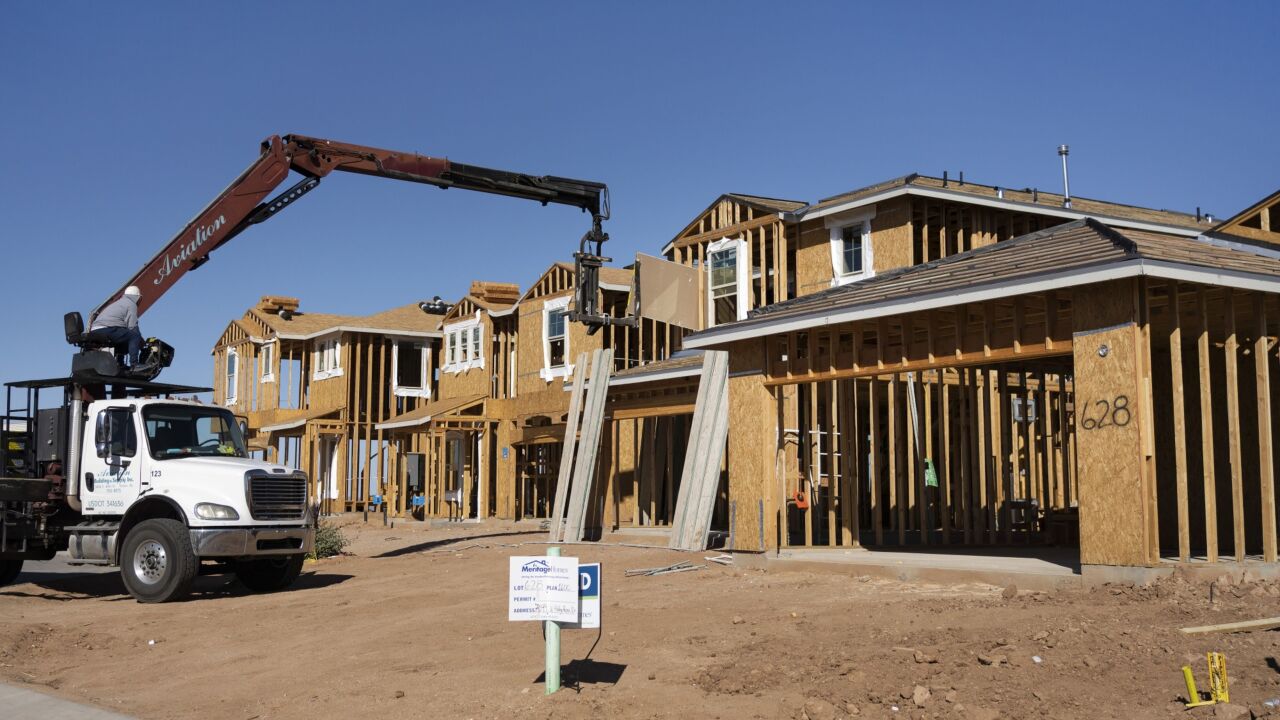Builders broke ground on 1 million homes in May, indicating the industry is picking up this quarter after a weather-induced slump to start the year.
The number of housing starts last month was in line with the median forecast of economists surveyed by Bloomberg and followed April's 1.07 million annualized rate that was the most since November, a Commerce Department report showed today in Washington. Permits, a proxy for future construction, decreased, reflecting a decline in the volatile multifamily category.
A strengthening job market and a retreat in mortgage costs in recent weeks is helping support residential real-estate following a lull in building in early 2014. Faster sales will prompt developers to step up construction, given supplies of homes on the market remain lean and property values are rising.
"Housing is fine," said Brian Jones, a senior U.S. economist at Societe Generale in New York, who forecast 1 million starts. "Demand is improving."
Another report today showed the consumer price index increased 0.4% after climbing 0.3% the prior month, according to figures from the Labor Department. Costs rose 2.1% in the past 12 months after a 2% year-over-year gain in April.
The median forecast of 78 economists surveyed by Bloomberg projected May housing starts would come in at a 1.03 million pace. Estimates ranged from 950,000 to 1.1 million. The prior month's reading was similar to the previously reported pace.
Permits decreased 6.4% to a 991,000 annualized rate. They were projected to ease to a 1.05 million pace, according to the survey median. Applications for multifamily work dropped 19.5%, while those for single-family projects that make up the biggest share of the market rose 3.7% to the highest level since November.
Construction of single-family houses declined 5.9% to a 625,000 rate from 664,000 the prior month.
Work on multifamily homes, such as condominiums and apartment buildings, decreased 7.6% to an annual rate of 376,000.
Three of four regions had a decrease in starts last month, led by a 25.2% drop in the Northeast. Work began on 7.3% more houses in the South, today's report showed.
Sentiment in
MDC Holdings Inc., a Denver-based homebuilder, is among those seeing a gradual recovery.
"Interest rates still remain at historically low levels, in fact we've seen them kind of move down here recently over the last several weeks," John Stephens, chief financial officer, said during a June 5 conference presentation. "We need to see improvements in consumer confidence and job growth, really, which is really going to drive homebuilding at the end of the day."
Faster hiring and more widespread access to credit would help spur demand for homes. Payrolls in May exceeded the pre- recession peak for the first time, according to Labor Department data. Employment grew by 217,000 after increasing by 282,000 in April. It marked the fourth consecutive month of gains of more than 200,000, the first time that's happened since early 2000. The jobless rate held at an almost six-year low of 6.3%.
Borrowing costs, which climbed in the second half of 2013, have retreated in the past month. The average 30-year, fixed-rate mortgage was 4.2% in the week ended June 12, down from 4.41% at the beginning of April, according to data from Freddie Mac. Overall, mortgage costs are still near historically low levels.
Increasing property prices are hurting affordability for those getting into the market, at the same time they also help homeowners feel wealthier and may keep boosting profits for builders.
Residential investment subtracted from growth over the past two quarters after boosting the economy since the end of 2010, according to Commerce Department figures. Gross domestic product shrank at a 1% annualized rate in the first three months of 2014 as homebuilding slowed.
Federal Reserve Chair Janet Yellen flagged housing as a risk to the outlook in testimony to Congress in May. Central bank officials also raised a warning flag about the "persistent slowdown in the housing sector," according to minutes of their April 29-30 meeting. Fed officials are set to gather today and tomorrow to discuss monetary policy.





